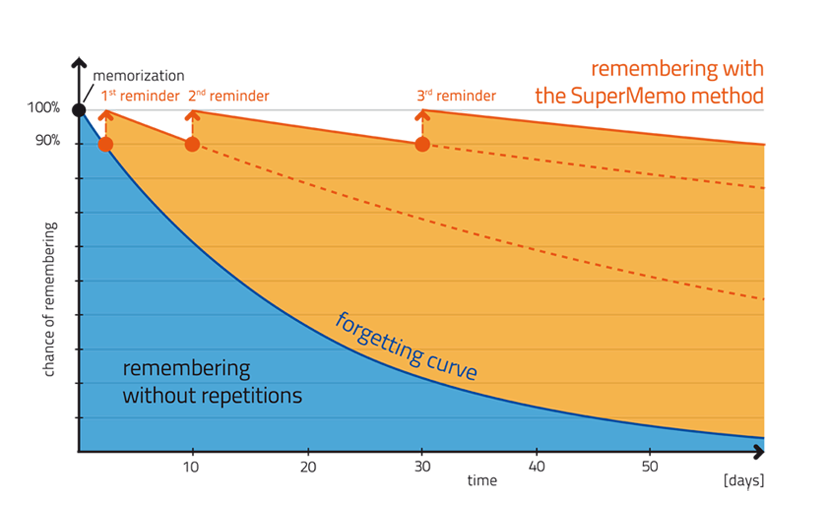Hey there! If you’re tackling med school, you already know the drill: there’s a mountain of stuff to remember. It’s not just about stuffing facts into your brain; being a great doctor means mastering skills like communication, decision-making, and leadership. But yeah, memorizing all those medical terms and processes is a big piece of the puzzle.
At Genius99, where many of us have walked the med school path, we’ve been pretty focused on one question: How can you memorize effectively? Our deep dive into cognitive psychology, chats with experts, and a bit of our own trial and error led us to a standout technique: spaced repetition.
You might have heard about spaced repetition, but what’s the real scoop on it? Is it the ultimate memory booster? In this article, we’re going to uncover the nuts and bolts of spaced repetition, sharing the insights we’ve gathered. Plus, we’ll let you in on how this technique is woven into the fabric of Genius99. Let’s get to it!

The Science Behind Spaced Repetition
Let’s face it, we humans are pretty forgetful. And honestly, that’s not such a bad thing. Imagine remembering every single thing you’ve ever seen or heard – like that random TikTok video from your morning scroll. Overload, right? It’s actually pretty handy that we get to pick and choose what sticks in our brains.

Ever heard of the forgetting curve? It’s this cool graph that shows how we tend to forget stuff over time. Picture this: you meet someone new, and bam, their name just vanishes from your memory. Totally normal. Holding onto memories means putting in a bit of effort.

Enter Hermann Ebbinghaus, a German psychologist from the late 1800s. This guy was a memory wizard. He’s the brain behind the forgetting curve and the spacing effect. Ebbinghaus found that if you study something a few times, spread out over a while (that’s spaced repetition for you), it sticks way better than cramming all that info in one go.
Let’s break it down with an example: Suppose you’re trying to memorize the bones in the human body for a test. If you study them intensively one day and then not again until the test, you’re likely to forget a lot. But, if you study a little each day, gradually increasing the time between sessions (say, day 1, day 3, day 7, and so on), you’ll retain the information much better. It’s like watering a plant regularly, not just flooding it once and hoping for the best.
But the real magic of putting spaced repetition to work in schools and learning? That’s thanks to the brainpower of other scientists who took Ebbinghaus’s ideas and ran with them.
Increased Intervals in Spaced Repetition
Now, we’ve got a handle on the fact that spaced repetition is a great way to remember stuff. But here’s the million-dollar question: how long should the intervals be between these study sessions? Luckily, there’s been a bunch of research on this, and we’ve got some solid answers.
Piotr Woźniak, a Polish researcher who dove deep into finding a practical way to use spaced repetition. His studies showed that expanding the intervals between study sessions actually helps lock in that information in your memory even better.
Woźniak wasn’t just theorizing; he put his ideas to the test. He experimented to nail down the best intervals for spaced repetition and ended up creating the SuperMemo algorithm. The big takeaway? Stretching out those intervals bit by bit really boosts how much you remember.

This SuperMemo algorithm isn’t just for research papers; it’s super practical and you can try it yourself with flashcards. It’s actually the same principle that powers the Anki algorithm. Here’s the nitty-gritty of how it works:
SM-2 Algorithm: The Steps
- First Repetition: Kick things off with an interval of 1 day.
- Second Repetition: Next up, set the interval to 6 days.
- Subsequent Repetitions: From the third time onwards, calculate the interval like this:
- Interval = Previous Interval * EF (Easiness Factor)
- EF Update Formula: EF + (0.1 – (5 – q) * (0.08 + (5 – q) * 0.02))
- q: Quality of response, on a scale of 0-5. 5 means you nailed it, 0 means total brain blank.
- Keep the EF above 1.3. If it dips below, just set it back to 1.3.
- Oops, Got it Wrong?: If your response quality (q) is under 3, reset the repetition count to start over.
In a nutshell, the magic of the SuperMemo and similar algorithms isn’t just in reminding you to review material; it’s all about those expanding intervals. This approach isn’t just a random choice – it’s backed by science. When you stretch out the time between your study sessions, you’re actually training your brain to retrieve information from deeper within your memory. It’s like working out a muscle – the more you use it, the stronger it gets.
So, what’s the big deal about these expanding intervals? They help turn what you’re learning from short-term memory blips into long-term knowledge. Each time you recall information after a longer break, you reinforce it more solidly in your memory. It’s a bit like building a bridge: the more support you add over time, the more stable it becomes. That’s why spaced repetition, especially with increasing intervals, is such a powerful tool in learning – it’s all about building knowledge that lasts.
The Testing Effect
Okay, so we’ve figured out that hitting the books just once isn’t going to cut it for long-term memorization. Repetition is key, but not just any repetition. We’ve seen that leaving gaps between study sessions and expanding those intervals over time is the golden ticket.

But wait, there’s more to it. It’s not just about how often you study, but how you study. You might think that going over your textbook again and again is the way to go. But here’s a twist: the testing effect says otherwise.
It turns out, when you’re just reading, you’re collecting information, but not necessarily learning how to bring it back up when you need it – like in an exam or a real-life situation. What you need is practice in pulling that information out of your brain, not just putting it in.
Enter the dynamic duo of cognitive psychology: Henry L. Roediger III and Jeffrey D. Karpicke. These guys dove deep into the concept of the testing effect, also known as retrieval practice, and brought it into the limelight in the early 21st century. Their work was a game-changer in understanding how actively recalling information actually helps lock it into our memory.
Here’s the gist: when you try to remember something you’ve learned, that very act of retrieving it makes that memory stronger. This means you’re more likely to remember it again later. This approach is a total contrast to the more traditional methods like just re-reading or highlighting stuff.

Roediger and Karpicke made waves with their “Testing Effect Study” in 2006. They found something pretty cool: students who got tested on what they’d learned held onto that info way better in the long run compared to students who just had more study time without any tests. This study wasn’t just about grades; it was about proving that the real power in learning comes from recalling, not just reviewing.
Feedback Enhances the Testing Effect
Retrieval practice is a powerful tool in learning, but it gets an extra boost when paired with feedback. Imagine every time you try to recall something, you immediately find out if you’re right or wrong. This feedback, especially when it corrects mistakes, significantly amplifies the benefits of the testing effect.
Feedback works wonders because it lets you know what you’ve nailed and where you’ve slipped up. It’s not just about catching errors; it’s also about confirming what you’ve got right. Studies show that when learners are given the correct answers post-retrieval, their ability to correct errors and solidify correct responses improves dramatically.
In essence, feedback is your learning GPS. It ensures you’re not just recalling but recalling correctly, making your study sessions more effective and your memory more accurate.
Retrieval Practice Enhances Transfer of Learning
As a medical student, it’s not just about memorizing facts and figures; it’s about deeply understanding and applying what you’ve learned. This is where the concept of ‘transfer of learning’ becomes crucial. The big question is, does spaced repetition and testing just help with memorization, or do they also aid in achieving a deeper understanding and application of knowledge?

A study by Butler highlights this very point. In his research, students were exposed to six prose passages containing several critical concepts. They were divided into groups: some repeatedly studied two of the passages, others repeatedly studied specific sentences with key concepts, and a third group was repeatedly tested on the critical concepts from the passages, receiving feedback after each test.
Here’s the catch: a week later, these students were tested on applying these concepts to new, inferential questions in the same knowledge domain. The results? The group that engaged in repeated testing showed a better ability to transfer and apply their knowledge to these new questions compared to those who merely restudied the material.
This study suggests that retrieval practice, a key component of spaced repetition, isn’t just about memorizing information. It actually enhances the ability to transfer and apply learning in different contexts – a critical skill for medical students who need to apply their knowledge in real-world scenarios.
Spaced Repetition in Action

Spaced repetition isn’t just a theory; it’s a practice that’s being used in real-life learning scenarios all over the world. If you’re a medical student, there’s a good chance you’re already familiar with Anki. This flashcard app on your smartphone is a classic example of spaced repetition at work. Each time you review a card and provide feedback on how well you remembered it, Anki adjusts the spacing interval. Struggle with a card? You’ll see it more often. Ace it? It’ll show up less frequently, stretching your memory just the right amount.
But spaced repetition isn’t limited to medical studies. Take Supermemo.com, for instance. This language learning application is built on the original concept of spaced repetition. Learning a new language involves a lot of memorization – think vocabulary, grammar rules, and phrases. Spaced repetition turns this daunting task into a manageable process, helping learners retain new words and concepts effectively over time.

And then there’s us at Genius99. We’re taking spaced repetition to the next level by integrating it into a learning app designed specifically for medical students. Our goal is to blend the principles of spaced repetition and the testing effect to create a learning experience that’s not just about memorization, but also about understanding and applying medical knowledge. Imagine learning about complex medical conditions, drug interactions, or surgical procedures in a way that sticks with you long term. That’s what we’re aiming for.
See the article “How we use spaced repetition in Genius99” to see how we built a learning model tailored for medical students.
Conclusion
In summary, spaced repetition isn’t just a learning strategy; it’s a revolution in how we absorb and retain information. At Genius99, we’re harnessing this powerful technique to transform medical education, making it more intuitive, effective, and tailored to the unique needs of each student. Whether it’s mastering the complexities of the human body or the intricacies of patient care, our app is designed to make your learning journey as efficient and impactful as possible.
Remember, with spaced repetition, you’re not just studying smarter; you’re building knowledge that lasts. So, get ready to experience a whole new way of learning that’s set to change the game for medical students everywhere.




